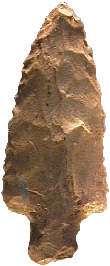

Point Type: LITTLE
BEAR CREEK
Also See: Adena, Bare Island, Crump Lake
Stemmed, Kays
, Kramer, Maples, Mulberry Creek, Pickwick, Ponchartrain
Location: Southeastern United States
Associated Dates:
4000 - 1500 B.P. - Late Archaic to Woodland
Morphology: Stemmed
General Description: The Little Bear Creek is a medium to large sized stemmed dart point or knife blade. The blade outline is triangular with slightly excurvate edges that can be very finely serrated. The distal end is usually acute. The shoulders are angular and barbed in a weak to tapered horizontal manner. The stem is straight, elongate, crudely flaked, often asymmetrical, and slightly tapered. The basal edge is straight to irregular to excurvate. On some specimens the rind of the parent material is left on the basal edge. The stem edges and sides are usually ground.
The Little Bear Creek is much like the Kramer point in both age and form with the exception being that the Kramer tends to have a much wider stem. The Little Bear Creek is one of many point types in the Late Archaic period that has contemporary counterparts which exhibit minor variations, and are found in widely separated areas. The Little Bear Creek is found at the Little Bear Creek site in Alabama as well as in western Tennessee and in parts of North Carolina.
The Little
Bear Creek size range is from 51 mm to 102 mm in length. The width varies from
19 mm to 30 mm. The stem width ranges from 14 mm to 18 mm. The stem length can
run from 14 mm to 20 mm long. Typical overall thickness is 6 mm to 11 mm.
The Little Bear Creek type was named by David
DeJarnette in 1948 for examples found at a site at the Little
Bear Creek site in Alabama.
About the Point Above: The Little Bear Creek point pictured at the top of this page, is average sized and is made from a dark brown matte chert. The point measures 69 mm in length and measures 27 mm at its widest point which is across the barbs. The maximum blade thickness is 11 mm. The stem is 14 mm long and is 14 mm wide at the base which is slightly ground along with the stem edges. Note that a basal corner is chipped off. The distal tip on this weary and worn specimen is obtuse and the beveling is bifacial on all four edges. The point was found near the town of Ringgold, Cherokee County, Alabama. Catalog Number 124-7-S
References: Baker, Cambron & Hulse, Dragoo (f), Justice (1), Overstreet, Perino (2, 4), Puckett (1)
© Copyright 1997 - 2009 LITHICS-Net WWW.LITHICSNET.COM
Use Your Browser's BACK Button to Return to the LITHICS-Net Index.